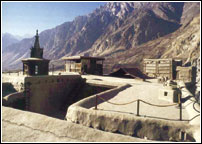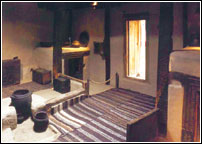 Nestled high in the mountains and surrounded by unrivalled vistas of rugged terrain, stands a 700-year-old fort which has been witness to the socio-cultural history of a resilient people, and to a remarkable feat ofmodern day conservation.
Nestled high in the mountains and surrounded by unrivalled vistas of rugged terrain, stands a 700-year-old fort which has been witness to the socio-cultural history of a resilient people, and to a remarkable feat ofmodern day conservation.
http://dawn.com/weekly/review/review4.htm
Dawn
The review
August 4, 2005
By Fauzia Husain
In a conservation effort that took nearly a decade to complete, one NGO has undertaken the comprehensive restoration and repair of Baltit Fort, making it a beautiful and functional building, writes Fauzia Husain
 Nestled high in the mountains and surrounded by unrivalled vistas of rugged terrain, stands a 700-year-old fort which has been witness to the socio-cultural history of a resilient people, and to a remarkable feat ofmodern day conservation.
Nestled high in the mountains and surrounded by unrivalled vistas of rugged terrain, stands a 700-year-old fort which has been witness to the socio-cultural history of a resilient people, and to a remarkable feat ofmodern day conservation.
The Baltit Fort, a symbol of Hunza’s history and culture, had lain abandoned for nearly half a century when the Mir of Hunza decided to hand it over to the Aga Khan Foundation for Conservation.
Considering its vital importance as a historic monument, and the fact that it is an important architectural marvel, the Aga Khan Foundation has converted this former residence into a viable public space to serve the community and generate funds for its own upkeep as well.
The Aga Khan Trust for Culture (AKTC) engaged Richard Hughes and Didier Lefort in 1985 to develop proposals that would save the Baltit Fort from further decay, and to formulate an imaginative programme for full-scale conservation of the complex.
The Baltit Fort restoration project presented a number of challenges.
First, the terrain; it is perched 2,800 meters up the Himalayan peaks in the Hunza valley. Hunza, located deep within the Karakoram mountains and fed by the upper catchment of the River Indus has until recently been an inaccessible and secluded part of northern Pakistan.
Yet, despite the seclusion of the valley until the opening of the Karakoram Highway in 1979, Hunza remained an important nexus for the movements of cultural exchange. The village elders still narrate tales of Alexander the Great and his army, while timeless relations with China, maintained along the historic silk route remain strong.
 Historic artefacts of the region also tell of rich relations with Kashmir, while, in the late nineteenth century, Hunza became an important arena for the power struggle between Russia, China and the British Empire.
Historic artefacts of the region also tell of rich relations with Kashmir, while, in the late nineteenth century, Hunza became an important arena for the power struggle between Russia, China and the British Empire.
Other challenges to the project included the need to preserve the monument against natural decay, while maintaining the historic character and appearance of the fort. The task force aimed for the project to serve as a demonstration of excellence, through the rigorous application of the highest international standards of conservation.
Under the tutelage of international experts, the AKTC hoped to utilize local workers as much as possible and train them in the principles and methods of conservation, thereby establish a pool of qualified professionals capable of undertaking future restoration projects.
In a conservation effort that took nearly a decade to complete, the team managed to complete comprehensive restoration and repair of the fort making it a beautiful, functional building. The Baltit Fort has now been converted into a museum and tourist attraction. It still serves as an integral part of the community that surrounds it.
The project was honoured in 2004 with an award for excellence in UNESCO’s 2004 Asia Pacific Heritage Award for Culture Heritage Conservation. Today, the Baltit Fort is an important monument in its rich cultural and symbolic value for the local community.
The Baltit Fort has always been the focal point of the valley. It has had tremendous archeological value as it yields strong evidence of a continuous past and a rich combination of the architectural devices typical to this area.
 In terms of architecture the Baltit Fort is fascinating as it is an old structure which has an organic connection to the site and settlement around it. This is typical of the architecture of the region, making allowances for the seismic instability of the area. Writer C.P Skrine, who visited the site in the early part of the 20th century has described the place as “Surely the most impressively situated medieval castle in the world.”
In terms of architecture the Baltit Fort is fascinating as it is an old structure which has an organic connection to the site and settlement around it. This is typical of the architecture of the region, making allowances for the seismic instability of the area. Writer C.P Skrine, who visited the site in the early part of the 20th century has described the place as “Surely the most impressively situated medieval castle in the world.”
Legend has it that this fortress was built to house a Hunza prince and a Baltistan princess, whose matrimonial alliance was hoped to bring protection to the kingdom. Until 1950, it was home to the ruling Mirs of Hunza before being gradually abandoned. While the fort may have lost its defensive role in the contemporary world, it remains as a symbol of Hunza’s history and culture.
A synthesis of the architectural form, domestic lifestyle and belief systems of the region, the fort holds an imposing position, dominating the village of Baltit (which has been renamed Karimabad in honour of Prince Karim Agha Khan) and overlooking Mount Rakaposhi, one of the highest summits in the Himalayan range.
Today, the Baltit Fort serves as a museum and cultural centre displaying local crafts for sale to visitors. The building now also contains a public library, a kitchen and an emergency staircase. Plumbing and lighting have been introduced, while five old houses adjacent to the fort have been acquired to provide space for ancillary facilities such as a ticket office, storerooms, showrooms, workshop facilities, and a coffeehouse with public toilet facilities. The project now attracts over 20,000 visitors a year, half of which are from outside the country.
Displaying artefacts, portraits and papers dating from the Middle Ages, the showcases in the fortress museum have nonetheless been kept to a minimum, allowing for the architecture of the building and it’s magnificent woodwork and masonry to stand out. On the roof a small Chinese bell is displayed, as a symbol of the good relations this region enjoys with its neighbour China.
Finally, the fort has become what conservationists had hoped it to be –– a tourist attraction, a centre for exchange of ideas, a resource centre, and a structure that continues to serve the community that is such an integral part of its history.
And most importantly, it has become an example for other similar projects in the region. Restoration work is being carried out for the rehabilitation of the Shigar Fort located near Skardu and it is hoped that soon this fort, too, will be converted into an important historical site and tourist destination.